MN 568 Unit 4 Quiz
1. Which of the following is associated with celiac disease (celiac sprue)?
2. The nurse practitioner (NP) suspects a patient has a peptic ulcer. Which of the following items on the history would lead the NP to this conclusion?
3. Which of the following dietary instructions should be given to a patient with GERD?
4. Which high-density lipoprotein (HDL) level is considered cardioprotective?
5. A patient is seen with complaints of diarrhea. Which of the following should be included in the patient’s differential diagnosis?
6. There are four stages of heart failure, classified as A to D, that describe the evolution and progression of disease. In which stage are patients hospitalized or treated with specialized interventions or hospice care for refractory symptoms of heart failure despite medical therapy?
7. A 28-year-old patient is seen in the clinic with colicky abdominal pain particular with meals. She has frequent constipation, flatulence, and abdominal distension. Which of the data make a diagnosis of diverticulitis unlikely?
8. Which ECG change is typical of cardiac ischemia?
9. What percentage of patients with angina pectoris will have simultaneous dyspnea, caused by transient increase in pulmonary venous pressures that accompany ventricular stiffening during an episode of myocardial ischemia?
10. A patient is diagnosed with GERD, and his endoscopic report reveals the presence of Barrett’s epithelium. Which of the following should the PCP include in the explanation of the pathology report?
11. A blood pressure (BP) of 150/90 is considered:
12. A 21-year-old student presents with complaints of fatigue, headache, anorexia, and a runny nose, all of which began about 2 weeks ago. She started taking vitamins and over-the-counter cold preparations but feels worse. The smell of food makes her nauseated. Her boyfriend had mononucleosis about a month ago, and she wonders if she might have it also. Examination reveals cervical adenopathy and an enlarged liver and spleen. Which of the following labs would be most helpful in the differential diagnosis at this point?
13. A 29-year-old Englishman is seen in the office with complaints of pain in his chest and belly. He has been suffering the pain for 2 weeks and gets temporary relief from Alka-Seltzer®. The burning pain wakes him at night and radiates up to his chest. Which factor favors a diagnosis of gastric ulcer?
14. In the CHADS2 Index for the stroke risk score for AF, the ‘A’ stands for:
15. Which test has long been considered the gold standard for a diagnosis of venous thromboembolism?
16. Statins are approved for which age group?
17. George, age 64, has cardiovascular disease (CVD), a total cholesterol of 280 mg/dL, and a systolic BP of 158. He is being treated for hypertension. You are doing a Framingham Risk Assessment on him. Which assessment factor would give him the highest number of points on the scale?
18. The American College of Cardiology/American Heart Association states which of the following regarding the use of non-statin lipid-lowering agents?
19. A 35-year-old female patient is seen in the clinic complaining of abdominal pain. Which of the following should be included in the history and physical examination?
20. When teaching post MI patients about their NTG tablets, the clinician should stress that the tablets should remain in the light-resistant bottle in which they are packaged and should not be put in another pill box or remain in areas that are or could become warm and humid. Once opened, the bottle must be dated and discarded after how many months?
21. A patient is diagnosed with giardia after a backpacking trip in the mountains. Which of the following would be an appropriate treatment?
22. Which of the following is abundant in the heart and rapidly rises in the bloodstream in the presence of heart failure, making it a good diagnostic test?
23. In which type of arterioventricular (AV) block does the pulse rate (PR) interval lengthen until a beat is dropped?
24. Nitroglycerine (NTG) is given for a patient having ischemic chest pain. One tablet or one spray should be used under the tongue every 5 minutes for three doses. What should be done if the pain has not been relieved after three doses?
25. For the best therapeutic effect after a myocardial infarction (MI), thrombolytics should be administered within the first 3 hours (ideally 30 minutes) of symptom onset. Studies have shown, however, that thrombolytic therapy can be of benefit up to how many hours after the initial presentation of MI symptoms?
26. A 25-year-old accountant is seen in the clinic complaining of crampy abdominal pain after meals. She is often constipated and takes laxatives, which are followed by a couple of days of diarrhea. She temporarily feels better after a bowel movement. She states she is embarrassed by flatulence and has abdominal distension. She has had no weight loss or blood in her stool. This problem has gone on for about 6 months. What should the next step be?
27. A patient is seen in the office with complaints of six to seven liquid bowel movements per day. Which of the following assessment findings would lead the NP to a diagnosis of inflammatory bowel disease?
28. Which type of angina do you suspect in Harvey, who complains of chest pain that occurs during sleep and most often in the early morning hours?
29. A 22-year-old is seen complaining of vague belly pain. This type of pain is seen at what point in appendicitis?
30. Which group would most benefit from statins?
31. A 46-year-old female patient is seen in the clinic with abdominal pain. Which of the following tests is essential for this patient?
32. The patient with GERD should be instructed to eliminate which of these activities?
33. A patient comes to the office complaining of constipation. The patient lists all of the following medications. Which drug could be responsible for the constipation?
34. Mr. J. K., 38 years old, is 5 feet 8 inches tall and weighs 189 pounds. He reports that he has had intermittent heartburn for several months and takes Tums® with temporary relief. He has been waking during the night with a burning sensation in his chest. Which additional information would lead you to believe that gastroesophageal reflux disease (GERD) is the cause of his pain?
35. If chest pain can be alleviated with time, analgesics, and heat applications, what might the differential diagnosis be?
36. A 45-year-old patient presents with a chief complaint of generalized abdominal pain. Her physical examination is remarkable for left lower quadrant tenderness. At this time, which of the following should be considered in the differential diagnosis?
37. A patient is seen with dark-colored urine, and the urine dipstick reveals a high level of bilirubin. Which of the following could be a cause of this problem?
38. A 28-year-old patient is seen with complaints of diarrhea. Which of the following responses to the history questions would help the primary care physician (PCP) establish the diagnosis of irritable bowel syndrome?
39. On further questioning, the 21-year-old patient with complaints of fatigue, headache, anorexia, and a runny nose explains that she is sexually active only with her boyfriend, does not use injectable drugs, and works as an aide in a day-care center. Which of the following tests would be most helpful in confirming your diagnosis?
40. A patient has acute pancreatitis with seven of the diagnostic criteria from Ranson’s criteria. In order to plan care, the NP must understand that this criteria score has which of the following meanings?
41. Sandra has palpitations that occur with muscle twitching, paresthesia, and fatigue. What specific diagnostic test might help determine the cause?
42. What value on the ankle-brachial index diagnoses peripheral artery disease?
43. Which heart sound may be heard with poorly controlled hypertension, angina, and ischemic heart disease?
44. You are assessing Sigred for metabolic syndrome. Which of her parameters is indicative of this syndrome?
45. Which of the following statements about dabigatran is true?
46. Samuel is going to the dentist for some work and must take endocarditis prophylaxis because of his history of:
47. You just started Martha on HTN therapy. The Eighth Joint National Committee recommends that if her goal BP is not reached in what length of time, you should increase the initial drug or add a second drug to it?
48. Which of the following is most effective in diagnosing appendicitis?
49. Which pain characteristic is usually indicative of cardiac pathology?
50. Jamie, age 55, has just started on a statin after having his liver function tests (LFTs) come back normal. He now asks you how often he has to have the LFTs repeated. What do you tell him?
| Institution & Term/Date | |
| Term/Date | Kaplan University |
MN 568 Unit 4 Quiz (Set 3)
- Product Code: 2022
- Availability: In Stock
-
$19.99
Related Products
MN 568 Unit 2 Quiz (Set 1)
$19.99
MN 568 Unit 2 Quiz (Set 2)
$19.99
MN 568 Unit 2 Quiz (Set 3)
$19.99
MN 568 Unit 4 Quiz (Set 2)
$19.99
MN 568 Unit 6 Quiz (Set 1)
$19.99
MN 568 Unit 6 Quiz (Set 2)
$19.99
MN 568 Unit 6 Quiz (Set 3)
$19.99
MN 568 Unit 8 Quiz (Set 1)
$19.99
MN 568 Unit 8 Quiz (Set 2)
$19.99
MN 568 Unit 8 Quiz (Set 3)
$19.99
MN 568 Unit 4 Quiz (Set 1)
$19.99

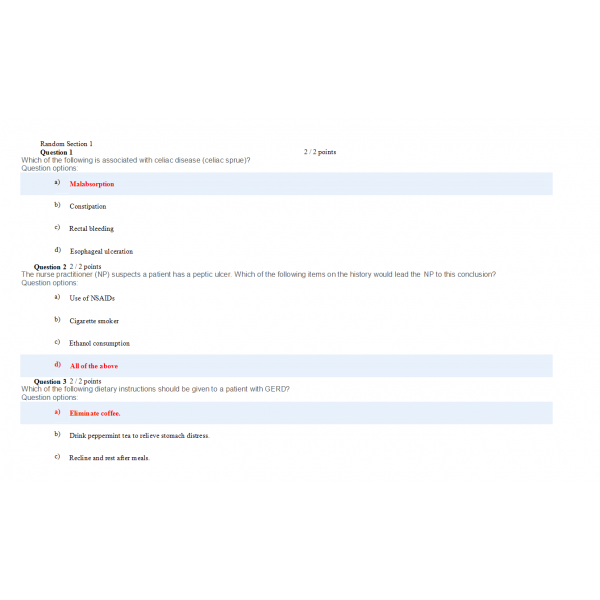
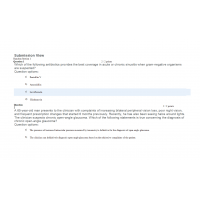
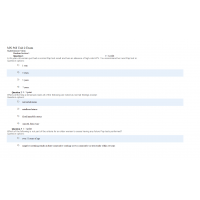
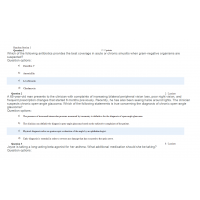
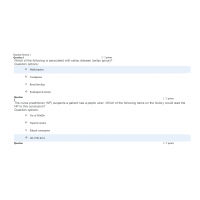
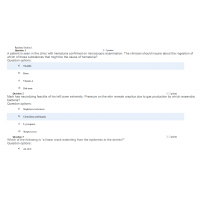
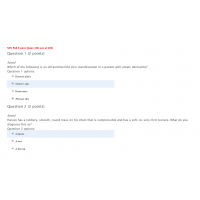
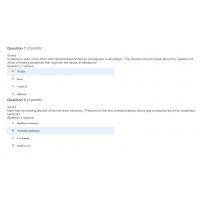
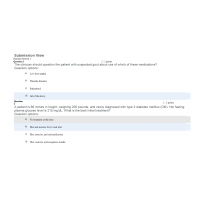
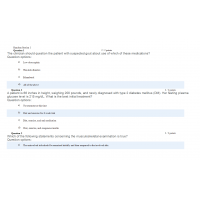
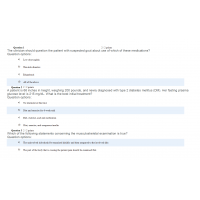
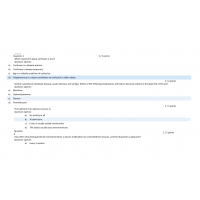
-200x200.JPG)
-200x200.JPG)